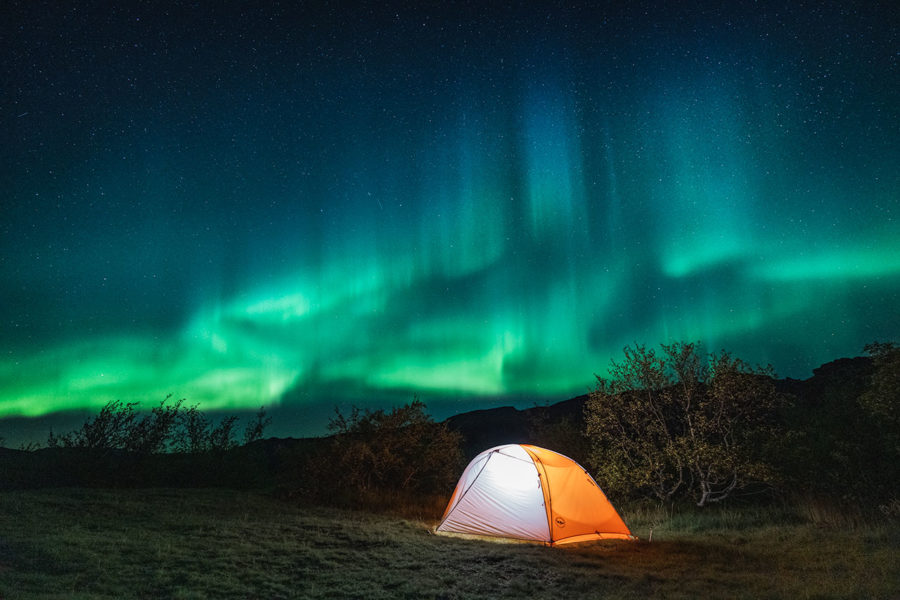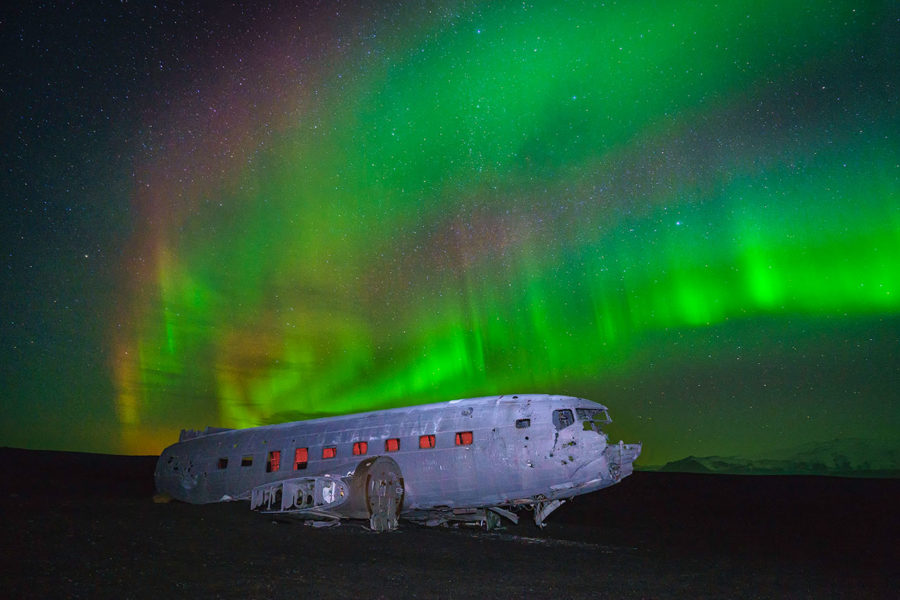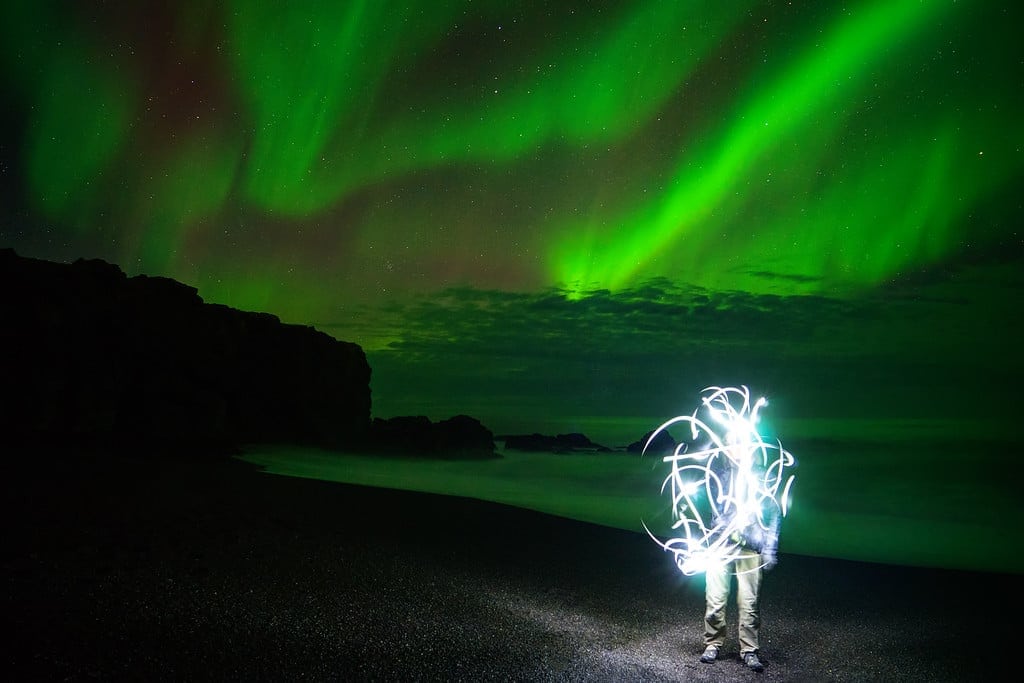
How To See The Northern Lights in Iceland
Photography Tips
Have you ever dreamed about seeing the colorful aurora borealis dancing in the night sky? Here’s how to find & photograph the amazing Northern Lights in Iceland!
Witnessing the magic of the northern lights at least once is a bucket-list experience for most people. I’ve been lucky enough to see and photograph the “Aurora Borealis” multiple times in a few different countries — including Iceland.
The northern lights can transfix you for hours, watching their mysterious green glow dance in the sky over the mountains or the sea.
Tracking down and shooting amazing photos of the northern lights in Iceland is always a top priority when I visit!
However many people don’t realize that this incredible natural phenomenon can often be elusive and unpredictable.
So to help you improve your chances, I’ve put together this guide on how to see and photograph the Northern Lights in Iceland. I’m going to share a few tips on how to find them, where to see them, as well as the camera settings and editing techniques I use.
Hopefully, you can capture great photos of this incredible phenomenon too!
Northern Lights Photography Guide

Experience the Magic of the Aurora!
How To Find The Northern Lights In Iceland
So why are the northern lights so difficult to see, even in Iceland? Well, it’s because there are many different factors involved.
For the optimal northern lights experience, you need a combination of dark skies, clear weather, and strong aurora activity. Ensuring that all these requirements come together takes some planning.
Seek Out Dark Skies
For the same reason star-gazing is better when it’s dark out, viewing the northern lights is best in the dark too. Light pollution from cities & towns hinders the experience.
Yes, you might be able to see the lights from Iceland’s capital city of Reykjavik occasionally. However you’ll have more luck in the countryside away from man-made light sources.
Avoid The Full Moon
If you can, try to avoid seeking out the northern lights during a full moon. The brightness of the moon can make it more difficult to see the aurora in the sky.
Also, remember that the moon rises and sets like the sun. So you can try and time your northern lights hunting when the moon is hidden away below the horizon for maximum darkness.
My favorite smartphone app for checking the moon rise and moon set schedule around the world is called The Photographer’s Ephemeris.
That said, sometimes a little bit of moonlight from a 1/4 moon can light up the background landscape just enough to create some spectacular images too!
Wait For Clear Weather
If the weather is overly cloudy, you won’t be able to find the northern lights. So pay attention to the weather forecast, especially cloud cover (infrared satellite maps help a lot).
While you might still see some aurora lights if it’s only partly cloudy, you’ll have the best chance when there are no clouds at all.
My favorite smartphone app for checking cloud cover conditions around the world is called MeteoEarth.
Check The Aurora Forecast
Because aurora activity comes down from the sun in space, scientists are able to predict how strong it will be by looking at our sun’s solar wind, and the strength of the Earth’s magnetic field. This “KP-Index” ranges from 0-9.
In my experience, you might have some luck seeing the northern lights in Iceland when the KP Index is 3 or 4. If you are lucky enough to be there when a solar storm hits (KP 5+), then you’ll have quite a show!
My favorite smartphone app for predicting the aurora is called My Aurora Forecast Pro.
For worldwide aurora predictions, Space Weather Ovation is also good.
Self-Drive vs. Group Tour
You should be able to go hunting for the northern lights on your own by renting a car in Iceland. Another option is renting a camper van, which allows you to get far away from towns and their street-light pollution.
Experience driving in snow is helpful if you’re visiting Iceland in the winter, as conditions can sometimes be very harsh. Big snowstorms are common.
I prefer exploring on my own, as it gives me the freedom to stay out all night or move locations on a whim.
However, if you don’t feel comfortable driving in Iceland at night, there are plenty of organized northern lights tours available too.

How To See The Northern Lights in Iceland
Best Time To See Northern Lights
Iceland’s best season to see the northern lights is the fall/winter months from September to April. The absolute darkest months are between November & February, but these months can also have the worst weather.
Remember that you need a combination of darkness away from towns, clear skies, and strong aurora activity to see the northern lights.
Witnessing Iceland’s northern lights during summer months is pretty rare, due to almost 20 hours of sunlight per day near the arctic circle.
The more time you spend in Iceland, the better your chances are of spotting the lights. If you’re only visiting on a 2-day stopover, you’ll need a LOT of luck to see them. I recommend spending at least 7 days in Iceland if you want to find the northern lights.
Even then it can be difficult. Some people can visit Iceland multiple times and never see them!
You probably won’t see the northern lights if you’re bar hopping in Reykjavik.
A primary reason why I was able to capture such great photos of the aurora borealis is that I stayed outside all night, for multiple nights, driving around searching for them. It takes some dedication.
For example, when I visited Iceland’s famous plane wreck in the middle of the night.
Where To Look For The Aurora
The best places to see the northern lights are in the northern latitudes. Think near the Arctic Circle.
The best viewing latitudes are between 68 degrees north to 74 degrees north. This includes Iceland. But some other good locations are the northern regions of Norway, Sweden, and Finland.
Greenland, Russia, Alaska, and Canada are also prime northern lights travel destinations.
Remember To Look North!
While it may seem obvious, remember to look North! The lights dance along the magnetic bands near the arctic circle, so you need to keep your eyes North to see them.
Weak aurora activity will look grey to the naked eye. Much like wispy clouds or fog moving in the wind. They can be easy to miss if you don’t realize it.
Aim your camera at the grey stuff and shoot a long-exposure photo (20 seconds or so). If those “clouds” come out green in your image, they aren’t clouds! You’re witnessing a weaker version of the northern lights.
The stronger the aurora activity, the brighter the colors will be.
The most common northern lights color you’ll see is green. However, if you’re lucky, they can also be blue, red, and orange depending on which atmospheric gasses happen to be prevalent.

Driving the Ring Road – 13 Seconds, f/4.0, ISO2000
Northern Lights Photography Tips
Once you find the Aurora, capturing decent images of it is a whole new challenge. Here are some tips to help you photograph the northern lights in Iceland.
Best Photography Gear
In most photography situations, the quality of your gear doesn’t matter too much. However for northern lights & star photography, it does.
Here’s a list of recommended gear you’ll want to produce some great low-light shots.
- Digital Camera with Manual Mode & High ISO Capability
- Wide Angle Lens (24mm or wider) with Fast Aperture (2.8 – 4.0 minimum)
- Sturdy Tripod
- 2-3 Extra Batteries
- Cold Weather Clothing
- Hand-warmer Heat Packs
You’ll want a quality camera (brand doesn’t really matter) with a large sensor for minimal noise at high ISO settings.
A wide angle lens aids in photographing large landscapes with the night sky.
A fast lens aperture allows the maximum amount of ambient light to enter your lens.
Sturdy travel tripods allow you shoot long exposures without producing camera shake.
Extra batteries give you the flexibility to stay out all night waiting for peak activity — plus cold weather drains them faster.
How To Focus Your Camera At Night
Even with the best camera gear and knowledge of the optimal settings, without proper focus, your northern lights photos won’t come out crisp/clear.
There are a few different methods for focusing your camera at night, but my favorite is to focus on a distant landmark (like mountains) on the horizon.
This is easier to do right before the sun sets, so it isn’t too dark.
Most cameras have an infinity focus setting (∞), but it’s not always accurate. Zoom in as much as possible and adjust the focus manually if needed.
Once you have it locked in, remember to switch “autofocus” off and don’t touch the lens focus ring. Sometimes it helps to “tape” down your focus ring so you don’t move it by accident later.
Video Tutorial: Photographing The Northern Lights
(Click to watch Northern Lights 101 – How To Photograph The Aurora on YouTube)
Northern Lights Camera Settings
Because the intensity of the light and amount of movement is constantly changing, you’ll have to experiment with your settings throughout the night.
Your camera should be set in Manual Mode, giving you the power to change each particular setting on its own.
IMAGE FORMAT
Most professional photographers shoot in RAW format rather than JPG, as it provides the maximum amount of information allowing for greater flexibility with post processing later.
It’s not necessary, but it does give you more wiggle room when editing the images.
APERTURE (F-STOP)
You want to capture as much light as possible, so use the widest (fastest) aperture your lens has. I recommend an aperture between F4.0 and F2.8.
To learn more about aperture, click here.
SHUTTER SPEED
Depending on how fast the lights are moving, or how bright they are, you’ll want to adjust your shutter speed (exposure) accordingly. Anything from 2 seconds to 13 seconds is a good place to start.
The faster the lights are moving, the shorter the shutter speed should be. Otherwise, you’ll end up with a massive blob of the overexposed green sky…
ISO
The last setting you should adjust for northern lights photos is ISO. Increasing ISO allows your sensor to capture more light. The downside is that the higher your ISO is, the more sensor noise you’ll get, resulting in a grainy image.
Generally, I shoot my northern lights photos using an ISO of 1000 – 4000 which seems to work best.

Before Processing

After Processing
Post-Processing Your Aurora Images
Once you have a decent image, you can enhance your Iceland northern lights photos with post-processing software. I personally use a combination of Adobe Lightroom and Adobe Photoshop, but there are others.
They all basically do the same things. How much processing you do to your photos is a matter of preference. Remember, art is subjective! You and I may not like the same things.
Post-processing is a huge topic though, so I’ll just give you a super quick overview of what I did to enhance my northern lights images to really make them pop.
- Adjust White Balance
- Increase Exposure
- Brighten Shadows
- Brighten Whites
- Darken Highlights
- Increase Clarity, Vibrance, and Saturation
- Adjust Curves
- Noise Reduction
- Sharpening
Happy Northern Lights Hunting!
The Iceland northern lights photography featured here was captured in the fall, over multiple trips while driving around Iceland’s famous Ring Road.
The lights would usually start off weak, increasing in intensity over the course of a few hours. The best shots were captured at peak aurora activity, which usually only lasted for about 10-15 minutes.
Patience & dedication is soooo important for northern lights photography… you need to stick around long enough for the good stuff to show itself.
With a little planning, a lot of waiting, and a dash of luck, you too can witness this amazing natural phenomenon in Iceland called the northern lights.
There’s nothing like seeing the northern lights in person! It’s magic. ★
Source: Destination Europe - expertvagabond.com


